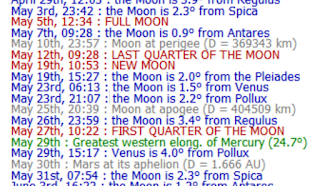The chart and listing highlight interesting celestial events for the month.
I used the "sky tonight" and the "phenomena of the month" reports.
Data based on local daylight time for St Thomas in south-western Ontario.
I did not create or add a legend.
The planets are shown with lines in the following colours:
- grey - Mercury
- white - Venus
- orange - Mars
- yellow - Jupiter
- green - Saturn
- aquamarine - Uranus
- dark blue - Neptune
Other:
- light blue - midnight
Venus is prominent in the evening sky but starts dipping. Saturn begins the shift from morning to evening skies. Mars crosses midnight. And Jupiter climbs out of the morning dawn...
And here's the list of notable events.
There you have it.§
Here's the "phenomena" report. Each entry starts with day number.
- 00:43 - opposition of asteroid 32 Pomona (dist. to Sun = 2.392 AU; mag = 10.3)
- 22:24 - meteor shower : Eta Aquarids (50/hour at zenith; duration = 38 days) [full Moon, boo!]
- 09:13 - comet C/2020 V2 ZTF perihelion (dist. to Sun = 2.228 AU; mag = 10.9)
- 21:38 - comet C/2020 K1 PANSTARRS perihelion (dist. to Sun = 3.073 AU; mag = 12.5)
- 23:46 - close encounter between Mars and Pollux, 5.0°
- 12:21 - close encounter between Venus and M 35, 1.8°
- 05:58 - simultaneous transits on Jupiter: one satellite and shadows of two satellites
- 14:04 - meteor shower : Eta Lyrids (3/hour at zenith; duration = 11 days) [Moon still bright, low ZHR...]
- 04:45 - beginning of lunar occultation of 95-psi3 Aqr (mag = 4.99)
- 08:48 - end of lunar occultation of Jupiter (mag = -2.06)
- 05:18 - opposition of asteroid 44 Nysa (dist. to Sun = 2.590 AU; mag = 10.2)
- 22:35 - beginning of lunar occultation of 76 Gem (mag = 5.30)
- 23:31 - end of occultation of 76 Gem
Now we've a decent list of events for May 2023...




No comments:
Post a Comment